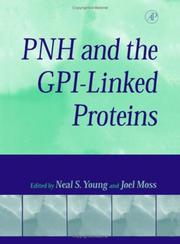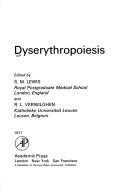| Listing 1 - 10 of 22 | << page >> |
Sort by
|
Book
ISBN: 0801870291 9780801870293 Year: 1999 Publisher: Baltimore, Md. Johns Hopkins University Press
Abstract | Keywords | Export | Availability | Bookmark
 Loading...
Loading...Choose an application
- Reference Manager
- EndNote
- RefWorks (Direct export to RefWorks)
Periodical
Abstract | Keywords | Export | Availability | Bookmark
 Loading...
Loading...Choose an application
- Reference Manager
- EndNote
- RefWorks (Direct export to RefWorks)
Anemia --- Anémie --- Periodicals --- Périodiques --- Anemia. --- haematology --- anaemia --- Anaemia --- Blood --- Anemias --- Hepcidins --- Diseases --- Pathological haematology --- Hematologic Diseases
Book
ISBN: 178985444X 1789854431 1838806423 Year: 2019 Publisher: IntechOpen
Abstract | Keywords | Export | Availability | Bookmark
 Loading...
Loading...Choose an application
- Reference Manager
- EndNote
- RefWorks (Direct export to RefWorks)
Iron deficiency (ID) and iron deficiency anemia (IDA) are prevalent conditions all over the world. The groups at highest risk are children, pre-menopausal women and socially disadvantaged people. Diagnose of ID using a full blood examination and iron studies can be difficulted by concomitant inflammation. Management of ID involves identification and treatment of its cause, as well as effective iron replacement. Patients who fail to respond to iron replacement will performed an endoscopy to exclude internal bleeding. Both enteral and parenteral iron are effective at replacing iron. For adult patients, we recommend trialling daily oral iron (30-100 mg of iron) as the first-line therapy. Patients who fail to respond to oral iron replacement can be safely managed with intravenous iron.
Anemia. --- Anaemia --- Blood --- Diseases --- Medicine --- Hematology --- Health Sciences
Book
Abstract | Keywords | Export | Availability | Bookmark
 Loading...
Loading...Choose an application
- Reference Manager
- EndNote
- RefWorks (Direct export to RefWorks)
This eBook is a collection of articles from a Frontiers Research Topic. Frontiers Research Topics are very popular trademarks of the Frontiers Journals Series: they are collections of at least ten articles, all centered on a particular subject. With their unique mix of varied contributions from Original Research to Review Articles, Frontiers Research Topics unify the most influential researchers, the latest key findings and historical advances in a hot research area! Find out more on how to host your own Frontiers Research Topic or contribute to one as an author by contacting the Frontiers Editorial Office: frontiersin.org/about/contact
Reticulocytes --- Erythrocytes --- Erythropoiesis --- senescence --- Clearance --- Anaemia --- Membrane Physiology --- Rheology --- Microfluidics
Book
Abstract | Keywords | Export | Availability | Bookmark
 Loading...
Loading...Choose an application
- Reference Manager
- EndNote
- RefWorks (Direct export to RefWorks)
This eBook is a collection of articles from a Frontiers Research Topic. Frontiers Research Topics are very popular trademarks of the Frontiers Journals Series: they are collections of at least ten articles, all centered on a particular subject. With their unique mix of varied contributions from Original Research to Review Articles, Frontiers Research Topics unify the most influential researchers, the latest key findings and historical advances in a hot research area! Find out more on how to host your own Frontiers Research Topic or contribute to one as an author by contacting the Frontiers Editorial Office: frontiersin.org/about/contact
Science: general issues --- Physiology --- Reticulocytes --- Erythrocytes --- Erythropoiesis --- senescence --- Clearance --- Anaemia --- Membrane Physiology --- Rheology --- Microfluidics --- Reticulocytes --- Erythrocytes --- Erythropoiesis --- senescence --- Clearance --- Anaemia --- Membrane Physiology --- Rheology --- Microfluidics
Book
ISBN: 9535137751 9535137743 9535140000 Year: 2018 Publisher: IntechOpen
Abstract | Keywords | Export | Availability | Bookmark
 Loading...
Loading...Choose an application
- Reference Manager
- EndNote
- RefWorks (Direct export to RefWorks)
This book deals with a very common condition, anemia, which might interest not only the physicians but also other healthcare professionals and researchers dealing with anemic patients. The objective of this book was to collect and compile up-to-date information from reputable researchers of different countries of the world to disseminate the latest information about the common types of anemia in some specific physiological and pathological conditions including pathophysiology and the use of algorithms as a tool to minimize the laboratory tests and accurate diagnosis of the underlying cause. In total, there are 13 chapters in this book where the authors shared their research findings and real-life experiences in managing their patients with anemia.
Anemia. --- Anaemia --- Blood --- Diseases --- Medicine --- Internal Medicine --- Infectious Diseases --- Health Sciences

ISBN: 1281005622 9786611005627 0080492096 0127729402 9780127729404 9780080492094 9781281005625 6611005625 Year: 2000 Publisher: San Diego : Academic Press,
Abstract | Keywords | Export | Availability | Bookmark
 Loading...
Loading...Choose an application
- Reference Manager
- EndNote
- RefWorks (Direct export to RefWorks)
Paroxysmal Nocturnal Hemoglobinuria (PNH) has been recognized for over a century. This mysterious disease is now understood at the level of the gene and the protein. The pathophysiology is related to a class of cell surface proteins with distinctive biochemical and physical characteristics. Recently it has been acknowledged that PNH is not rare, and once sensitive assays--based on the chemistry of the proteins--can be applied to many patients.Written by international experts in the field, this book includes a number of distinctive characteristics, such as the clinical features of PNH, the
Hemoglobinopathy. --- Anemia. --- Abnormal hemoglobin --- Hemoglobin, Abnormal --- Anemia --- Hemoglobin polymorphisms --- Anaemia --- Blood --- Diseases
Book
Abstract | Keywords | Export | Availability | Bookmark
 Loading...
Loading...Choose an application
- Reference Manager
- EndNote
- RefWorks (Direct export to RefWorks)
This eBook is a collection of articles from a Frontiers Research Topic. Frontiers Research Topics are very popular trademarks of the Frontiers Journals Series: they are collections of at least ten articles, all centered on a particular subject. With their unique mix of varied contributions from Original Research to Review Articles, Frontiers Research Topics unify the most influential researchers, the latest key findings and historical advances in a hot research area! Find out more on how to host your own Frontiers Research Topic or contribute to one as an author by contacting the Frontiers Editorial Office: frontiersin.org/about/contact
Science: general issues --- Physiology --- Reticulocytes --- Erythrocytes --- Erythropoiesis --- senescence --- Clearance --- Anaemia --- Membrane Physiology --- Rheology --- Microfluidics

Abstract | Keywords | Export | Availability | Bookmark
 Loading...
Loading...Choose an application
- Reference Manager
- EndNote
- RefWorks (Direct export to RefWorks)
Erythropoiesis. --- Anemia --- -Erythrocyte disorders --- -Erythropoiesis --- -Academic collection --- Hematopoiesis --- Erythrocytes --- Blood --- Anaemia --- Erythropoieses --- Congresses --- Diseases --- Erythrocyte disorders --- Erythropoiesis --- Academic collection
Dissertation

Year: 2019 Publisher: Liège Université de Liège (ULiège)
Abstract | Keywords | Export | Availability | Bookmark
 Loading...
Loading...Choose an application
- Reference Manager
- EndNote
- RefWorks (Direct export to RefWorks)
L’anémie hémolytique à médiation immune fait partie des manifestations les plus fréquentes de trouble auto-immun et hématologique chez nos animaux de compagnie. Elle se caractérise par une lyse excessive des érythrocytes de l’hôte par son propre système immunitaire. Bien que le mécanisme et la gestion thérapeutique de cette pathologie soient actuellement bien connus, le taux de mortalité reste élevé. Un bilan d’extension thoracique et abdominal est actuellement recommandé afin de trouver la cause de l’hémolyse. Il existe cependant, un manque de données standardisées concernant les résultats échographiques chez les animaux de compagnie atteints d'anémie hémolytique à médiation immune (IMHA). Le but de cette étude est d’identifier les anomalies abdominales visibles à l’échographie, chez des patients atteints d’IMHA. Les résultats échographiques de 69 patients (61 chiens et 8 chats) pris en charge à l'Hôpital Vétérinaire de Liège entre 2013 et 2018 ont été examinés et détaillés en fonction de la cause de l’IMHA. Les résultats échographiques étaient compatibles avec une hématopoïèse extra-médullaire ainsi que des modifications hypoxiques et réactionnelles. Une augmentation modérée à sévère de la taille (63,8% ; 44/69) et de l'échogénicité hépatique (52,2% ; 36/69) a été fréquemment observée. Sur la plupart de nos patients (20,3% ; 14/69), le parenchyme présentait un aspect nodulaire et hétérogène. Une splénomégalie et un parenchyme splénique hétérogène ont été rapportés chez 40 (58% ; 40/69) et 31 patients (45% ; 31/69), respectivement. Un épanchement abdominal léger à modéré a été observé chez 32 patients (46,4% ; 32/69), particulièrement en partie crâniale (27,5% ; 19/69). Les spots hyperéchogènes libres dans la vessie étaient fréquents (50,7% ; 35/69). Enfin, un tiers (33,3% ; 23/69) ont présenté un élargissement des ganglions lymphatiques abdominaux. Immune-mediated haemolytic anaemia is one of the most common manifestations of autoimmune and haematological disorders in companion animals. It is characterized by an excessive lysis of the erythrocytes of the host by its own immune system. Although the mechanism and therapeutic management of this pathology are currently well known, the mortality rate remains high. An assessment of thoracic and abdominal extension is currently recommended to find the cause of haemolysis. However, there is a lack of standardized data regarding ultrasonographic findings in companion animals affected by immune-mediated haemolytic anaemia (IMHA). The aim of this study is to identify the anomalies on abdominal ultrasound scans in patients suffering from IMHA. The ultrasonographic findings from 69 patients (61 dogs and 8 cats) seen at the Veterinary Hospital of Liège University between the year 2013 and 2018 were screened and itemized according to the cause of the IMHA. The ultrasonographic findings were consistent with extramedullary haematopoiesis as well as hypoxic and reactive changes. A moderate to severe increase in hepatic size (63,8%; 44/69) and echogenicity (52,2%; 36/69) was frequently seen, along with nodular and heterogeneous hepatic parenchyma (20,3%; 14/69). Splenomegaly and heterogeneous splenic parenchyma were reported in 40 (58%; 40/69) and 31 patients (45%; 31/69) respectively. Mild to moderate abdominal effusion was found in 32 patients (46,4%; 32/69). Floating hyperechoic spots in the urinary bladder were frequent (50,7%; 35/69). Finally, a third (33,3%; 23/69) presented enlargement of abdominal lymph nodes.
| Listing 1 - 10 of 22 | << page >> |
Sort by
|

 Search
Search Feedback
Feedback About UniCat
About UniCat  Help
Help News
News